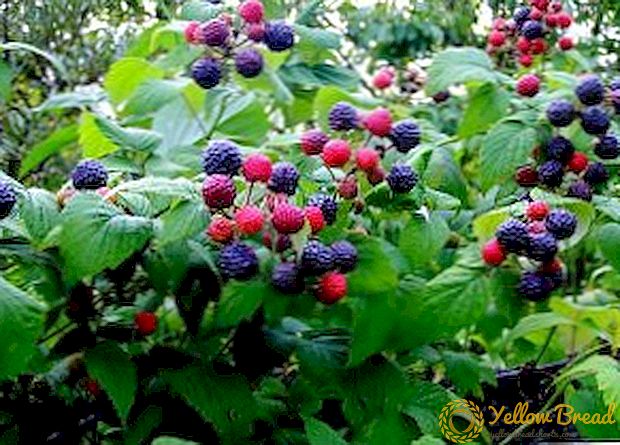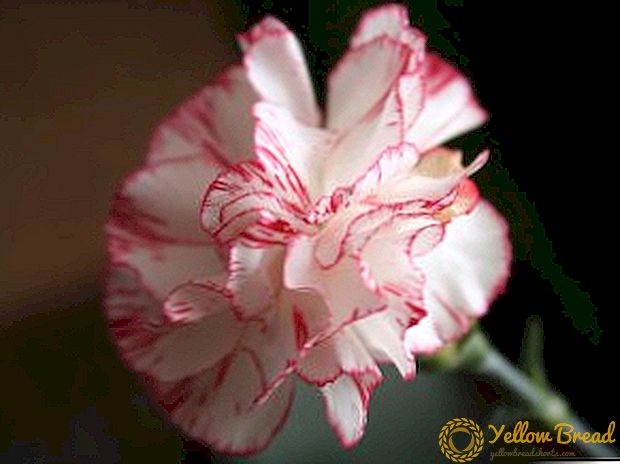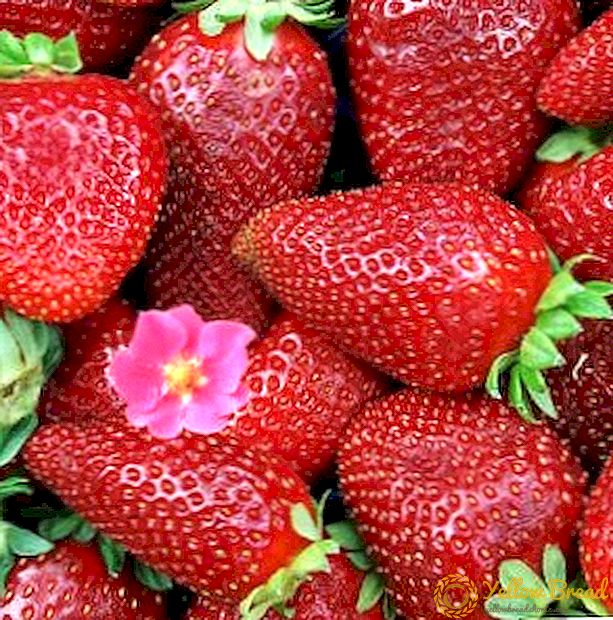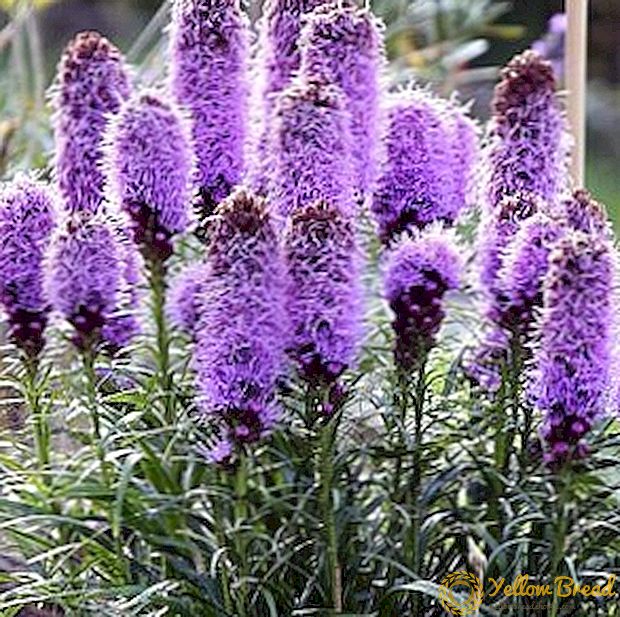 For certain, the birthplace of the gooseberry is not clear. Various authors write about Western Europe, Africa, the Caucasus, America. We have this berry known and loved for a long time. Many new varieties have appeared by the selection method, both those that are not very often found on our plots, and those that are in constant demand among gardeners. One of the best domestic varieties of gooseberry - "Gingerbread Man".
For certain, the birthplace of the gooseberry is not clear. Various authors write about Western Europe, Africa, the Caucasus, America. We have this berry known and loved for a long time. Many new varieties have appeared by the selection method, both those that are not very often found on our plots, and those that are in constant demand among gardeners. One of the best domestic varieties of gooseberry - "Gingerbread Man".
- History of gooseberry breeding "Kolobok"
- Characteristics and characteristics of the variety
- Pros and cons of gooseberry "Kolobok"
- How to choose seedlings when buying
- Dates and choice of place for landing
- Preparatory work before landing
- Planting young seedlings on your site
- Care and cultivation of gooseberry variety "Kolobok"
- Watering, weeding and loosening the soil
- Fertilization
- Cropping and crown formation
- Shelter bushes for the winter
- Terms of ripening and harvesting
History of gooseberry breeding "Kolobok"
The variety has been known since 1988. Country of origin - the USSR (RSFSR). It was derived by the experts of the VSTISP (All-Russian Breeding and Technological Institute of Horticulture and Nurserymen). The variety was created in 1977 by crossing the variety "Pink 2" with the variety "Change", was tested in 1988, after which it was entered in the state register. This is a table variety, famous for its excellent taste in both fresh and processed form. Used to make desserts, pastries, jams, pastes, juices, suitable for freezing.
Characteristics and characteristics of the variety
Gooseberry "Kolobok" has the following description: bush lush, strong-growing, sprawling, with powerful shoots. It has medium (up to 3-4 g) and large (up to 7-8 g) berries spherical or slightly elongated. The ripened berry can long remain on the bush and does not crumble. The color of berries - amber-brown-red. The flesh is juicy, dense, sweet, with a slight sourness; peel - edible, thick, glossy, without a gun. 
The leaves are small, toothed, from below - gray-green matte, on top - rich dark green glossy. The shoots are powerful. Gooseberry "Gingerbread Man" in height reaches 1.5 m, but at the same time the branches of the bush often lean down, forming an arc. Young stems are smooth, lignified, with a grayish-brown bark and almost without thorns. Spines are only in the internodes of the leaves.
Pros and cons of gooseberry "Kolobok"
One of the advantages is a good winter hardiness of the gooseberry "Kolobok" (in winter the bushes practically do not freeze out), as well as endurance, unpretentiousness, stable yield, resistance to the anthracnose and powdery mildew pathogens. Gooseberry "Kolobok" is an early variety: ripening berries falls on the beginning-middle of July and lasts until the end of summer.
The yield of gooseberry "Kolobok" - up to 9-10 kg of berries from a bush. The berries are not only tasty, but also useful - they contain a large amount of vitamin C (24-28 mg / 100 g). With all the advantages of the variety, it should be borne in mind that "Kolobok" does not tolerate the alternation of frost and thaw. During such periods, he may even die - he is not so afraid of frosts, as temperature drops. 
How to choose seedlings when buying
It is better to buy in a nursery or from a reputable breeder, where there is a large selection of healthy gooseberry seedlings. The cost of good seedlings will quickly pay off.
Dates and choice of place for landing
Gooseberries are planted in spring or autumn. Spring is planted from late March - early April. If you plant in the winter, then in September - the plant should have time to completely take root before frost. Better yet the gooseberry "Kolobok" planted in the fall: Autumn planting is preferable for the survival of the seedling and will facilitate subsequent care, as in the spring gooseberry buds bloom early, and often occurring spring frosts can kill them. In the fall, the young plant takes root, tempered and winters normally, and since spring it has been growing to its full height.
Under the landing choose an open place on the sunny side of the site.
Preparatory work before landing
The optimal soil for gooseberries is fertile loamy, but it also grows well on clayey, sandy loam. It develops poorly on a marshy, strongly podzolic soil.Does not like strongly acid soils, so if the soil is acidic - it must be deoxidized to slightly acidic - pH to 5.5. To do this, use chalk, limestone, dolomite flour; they are made in advance - not in the year when the gooseberry is planted, but a year before it.
Prepare a plot for planting for two or three weeks - cleared of weeds, deeply dug up (30 cm) and leveled, eliminating large lumps.
Planting young seedlings on your site
The diameter of the pit under the gooseberry is 45–55 cm, the depth is up to 45–50 cm. The top layer of the earth and organic or mineral fertilizers are evenly thrown over the bottom. The seedling is set in the center and added dropwise at the very branching, but not lower than 6-7 cm of the root neck. Then lightly tamp the soil, mulch (rotted leaves, peat, hay, straw) and watered. For gooseberry "Kolobok" the following planting pattern is used - 2 × 1.5 or 1.7 × 1.7. If you plant more densely, the height of the bush, its spreading and yield decreases. 
Care and cultivation of gooseberry variety "Kolobok"
With the proper planting of the gooseberry "Kolobok", its further cultivation is simple - watering, loosening, weed, pest control, spring and autumn digging, and adding supplements.
Watering, weeding and loosening the soil
Water as the soil dries, but not allowing complete drying or stagnation of water. Watering should be uniform - often but moderately. Big breaks without water will cause the berries to crack. Weeding is carried out for the destruction of weeds and loosening. Loosen after watering and fertilizing. Under the mulch at first, the soil can not loosen.
Fertilization
Fertilizers for gooseberries contribute when planting - at the bottom of the pit. Both organic and mineral fertilizers are used for this. For example, use the following dressings: compost, humus, peat - 0.5 - 1 bucket per hole; wood ash - 500-600 g per pit; superphosphate - 180-250 g per well. You can fertilize and after planting before mulching - mineral fertilizers are diluted in water and watered already planted seedlings. Later it is fertilized every year - either in the fall, digging the earth, or until digging in the spring. Fertilizers are the same as when planting.
Cropping and crown formation
Pruned "Kolobok" when planting - only 5-6 buds are left on the same-year branches. This gives strong growth to the frame-forming branches of the bush. When planting gooseberry "Kolobok", you need to know that its pruning should be regular in the future. 
The gooseberry does not like shading and with strong branching it grows poorly and becomes shallow. The plant is abundantly fruiting, with the development of 23-25 uneven-aged stems. Older branches that have lost their fruitfulness are removed, leaving strong younger ones.
Ideally, as the bush grows, 4-5 strong skeletal branches should be left during pruning. And constantly rejuvenate the bush - cutting off the dried out stems and leaving the lateral strong cuttings. In general, remove all damaged branches, interlaced, with signs of rot.
The last time during the season they cut the bush for the winter - in the beginning-middle of October - they cut it off as usual, but at the same time they remove all the branches that are more than five years old. Place slices necessarily treated with garden pitch.
Shelter bushes for the winter
After autumn pruning, the branches are gathered together, they are pressed and tied (not much) a bush in one or two places.
Then make dressing, dig up the soil (10-12 cm in the root zone, then - up to 20 cm), watered, mulched (peat, humus). First-year shrubs, and even more mature plants, are covered with spruce branches, agrospan, and any other improvised covering materials. If the snow falls a lot, then it is good for them to sprinkle the bush completely.
Terms of ripening and harvesting
Berries ripen by mid-summer - in July. Since the variety is seedless, harvesting is easy and safe. Harvested berries are stored for a long time, they are characterized by high transportability. 
If you, doing this gooseberry, did everything right - you chose good saplings, created the plant care you needed, provided fertilizing and pruning, then in the end you can get 10 kg of berries and more from one three-four-year-old bush.






